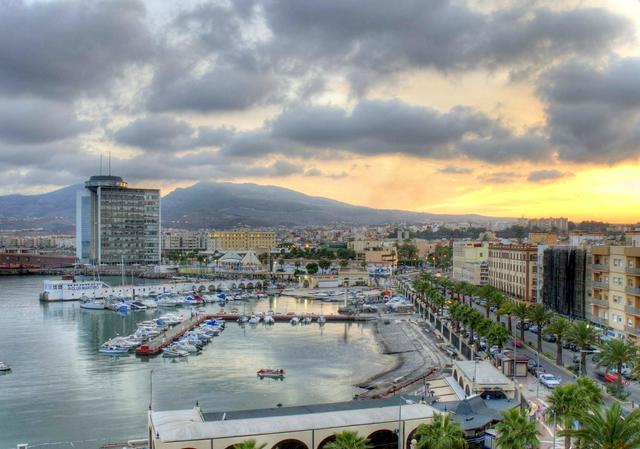 Melilla (Arabic: مليلية (Maliliyyah), Berber: ⵎⵔⵉⵜⵙ (Mřič)) is a Spanish exclave in North Africa, on the Moroccan side of the Mediterranean. In some ways, it's kind of like Ceuta but in other ways, it's a unique place.
Melilla (Arabic: مليلية (Maliliyyah), Berber: ⵎⵔⵉⵜⵙ (Mřič)) is a Spanish exclave in North Africa, on the Moroccan side of the Mediterranean. In some ways, it's kind of like Ceuta but in other ways, it's a unique place.
- Tourist information office, calle Fortuny 21, +34 952-67-54-44. Near the Plaza de Toros, but far from everything else. A better choice is to go to the Tourist Information kiosk outside the Casino Militar on the main plaza, Plaza Espana.
Tourist information office, calle Fortuny 21, +34 952-67-54-44. Near the Plaza de Toros, but far from everything else. A better choice is to go to the Tourist Information kiosk outside the Casino Militar on the main plaza, Plaza Espana.
You are in Spain. People speak Spanish. But you are also in North Africa, and many people speak Tarifit (Spanish: rifeño, a variety of Berber). French is also widely spoken amongst the Moroccans in Melilla.
- Melilla la Vieja. The fortified old town, on a hill overlooking the port. Its ramparts have Roman origins. There is an elevator built into the restored city wall.
- Modernismo. Architecture, throughout the city, but especially on calle López Moreno and calle del Rey Juan Carlos
- Or Zoruah Synagogue, Calle López Moreno Melilla, 8. Arabesque architecture, designed by Enrique Nieto in 1924. Downstairs a tacky bargain store, but the façade is well-preserved. Visits can be arranged through the Tourist Information Kiosk on the Plaza Espana.
- Plaza de España. Surrounded by monumental buildings such as the local assembly building, the Casino Militar, and the Bank of Spain.
Melilla la Vieja. The fortified old town, on a hill overlooking the port. Its ramparts have [[Roman Empire|Roman]] origins. There is an elevator built into the restored city wall.
Modernismo. Architecture, throughout the city, but especially on calle López Moreno and calle del Rey Juan Carlos
Or Zoruah Synagogue, Calle López Moreno Melilla, 8. Arabesque architecture, designed by Enrique Nieto in 1924. Downstairs a tacky bargain store, but the façade is well-preserved. Visits can be arranged through the Tourist Information Kiosk on the Plaza Espana.
Plaza de España. Surrounded by monumental buildings such as the local assembly building, the Casino Militar, and the Bank of Spain.
Melilla (like Ceuta) is a territorio franco, which means no VAT or other taxes.
- Cafetería Los Arcos, calle López Moreno (next to the Sagrado Corazón church. Spanish churros and café con leche, or Moroccan mint tea.
- Cafetería El Galan, calle Remonta (Straight in front of Melilla Comarcal hospital.. Andalusian Toast with fresh tomato and olive oil, and typical sandwiches.
Cafetería Los Arcos, calle López Moreno (next to the Sagrado Corazón church. Spanish churros and café con leche, or Moroccan mint tea.
Cafetería El Galan, calle Remonta (Straight in front of Melilla Comarcal hospital.. Andalusian Toast with fresh tomato and olive oil, and typical sandwiches.
The city is full of café/bars but the liveliest part is the Puerto Noray, opposite the big Hotel Puerto Melilla, which has many restaurants, bars and nightclubs. And all of the bars look over the marina.
Melilla is a safe city to visit, though not unconditionally so. There are always lots of people enjoying the beach, etc. until late; though it is not advisable to travel alone at night, even in the city centre. Street robbery is not an uncommon occurrence for people walking alone at night in Melilla.
Pickpocketing is relatively common here, especially in bathrooms where a common tactic is for a group of large men to crowd round the victim and basically empty every available pocket. It is a better idea to leave valuables with other friends before going to the bathroom, or failing that, to surreptitiously tuck your phone/wallet etc into your socks.
Catch a bus from the Plaza de España to the Moroccan border, 2km to the south. Cross the border into the Moroccan customs and security area and line up at the police kiosk to get your passport stamped. This can take a while. Be sure to go up to the window and ask for an entry form to fill out (in French, Spanish or English) while you wait. Be careful for scammers trying to sell you these forms or trying to "help" you fill them out. They will just run off with your passport.
When you get out you will be in the village of Beni Enzar which has the port of Nador with sailings to Almeria or France, where you can find banks (just next to the port)or a collective taxi to the city of Nador. Remember to turn your watch back one or two hours!
